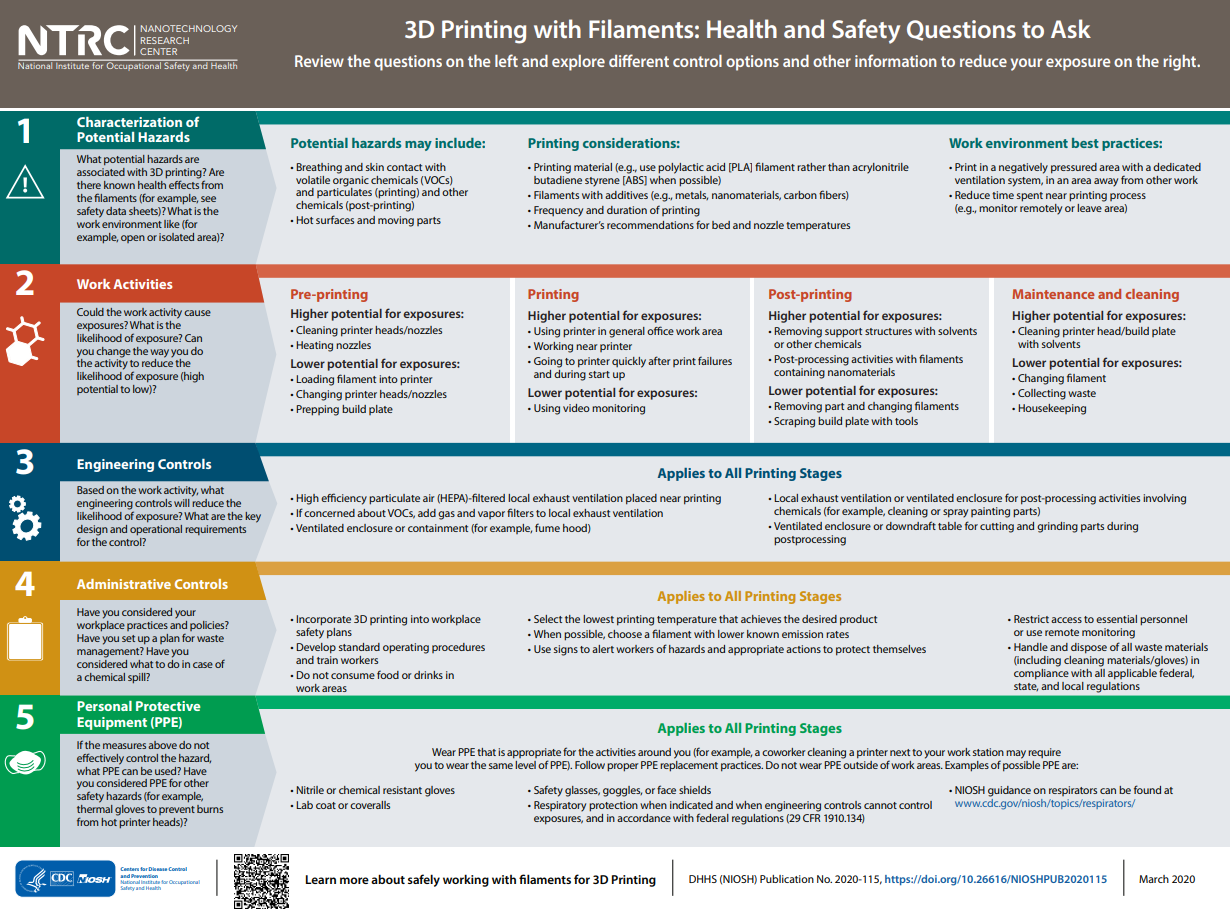The National Institute for Occupational Safety and Health (NIOSH) has published two new posters regarding 3D printing material safety for the workplace and at home. The first details steps that can be taken to ensure safe FDM operation with filaments and the second is concerned with metal powder handling.
The information compiled in the posters is a culmination of nearly five years of NIOSH’s direct field observations and laboratory research activities on the harmful effects of 3D printing emissions. NIOSH is currently conducting additional research on the potential effects of exposure to these emissions, some of which is in collaboration with the Environmental Protection Agency (EPA) and the Consumer Products Safety Commission (CPSC).
3D printing with filaments
The filament safety poster issued by NIOSH’s Nanotechnology Research Center (NTRC) starts by laying out areas to consider. Users should try to limit breathing and skin contact with volatile organic chemicals and any particulates that may be floating about during printing. FDM printers rely on hot surfaces and moving parts, some of which tend to move quite fast and may injure or burn the handler. In regards to material choice, PLA should be favored over ABS when possible and all printing should be done in a negatively pressured area with a dedicated ventilation system (HEPA is preferable).
Users should always be mindful of other individuals that may be in the area – this is especially important for close-quarters office environments. Time spent near the printers while they are running should be limited and remote camera monitoring should be utilized when possible.
The poster also makes a point of incorporating 3D printing procedures into general workplace safety plans and meetings. Even non-technical staff should be educated and trained if they are in the vicinity of the printers and a food and drink ban in work areas should be enforced.

3D printing with metal powders
The metal powder poster starts by stating that breathing and skin contact with the metal powders should be avoided and users should be aware of the risk of static-induced fire or explosion. Metal PBF machines use high-intensity lasers to melt and fuse the powder granules so users should also be mindful of contact with these. In line with the filament guidelines, printing should be done in a negatively pressured area with a HEPA filter. There should also be a fire suppression system in place in case of a fire.
When it comes to powder handling, loading and sieving should always take place in an enclosed environment or containment system. The same goes for part cleaning and post-processing, as loose powder is very fine and easy to spread. To mitigate risk in situations where powder does accidentally spread, sticky mats should be placed around the work area to limit the mobility of the granules.
As with the filament poster, it is recommended that metal powder 3D printing is incorporated into workplace safety plans. Food and drink should not be consumed in work areas and access should be limited to essential technical staff. The reactivity of the metal powders should always be considered (with air and cleaning agents) and work areas should be cleaned daily with wet cleaning methods.

Established and agreed upon health and safety standards are essential for the industrialization of any kind of technology. Earlier this year, Underwriters Laboratories and ASTM International signed a memorandum of understanding (MoU) to jointly develop an international ASTM-ISO standard for additive manufacturing facility safety management. Elsewhere, RadTech published a material handling health and safety poster for 3D printing resins. The poster covers risks that users should be mindful of when operating SLA and DLP 3D printers both in and out of the office.
The nominations for the 2020 3D Printing Industry Awards are now open. Who do you think should make the shortlists for this year’s show? Have your say now.
Subscribe to the 3D Printing Industry newsletter for the latest news in additive manufacturing. You can also stay connected by following us on Twitter and liking us on Facebook.
Looking for a career in additive manufacturing? Visit 3D Printing Jobs for a selection of roles in the industry.
Featured image shows an engineer wearing PPE to transport an SLM fabricated part for cleaning. Photo via Materialise.



